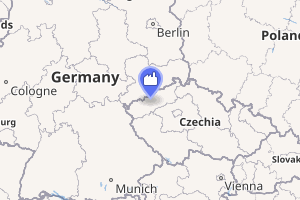Prunéřov Power Station
The Prunéřov Power Station (Czech: Elektrárna Prunéřov, EPRU) is the largest coal-fired power station in the Czech Republic with installed capacity of 1,490 MW. It is located near Kadaň.
| Prunéřov Power Station | |
|---|---|
EPRU II | |

| |
| Official name | Elektrárna Prunéřov |
| Country | Czech Republic |
| Location | Kadaň |
| Coordinates | 50.418°N 13.259°E |
| Status | Operational |
| Commission date | 1967-1968 (EPRU I), 1981-1982 (EPRU II) |
| Owner(s) | CEZ Group |
| Operator(s) | |
| Thermal power station | |
| Primary fuel | Lignite |
| Power generation | |
| Units operational | 4 × 110 MW (EPRU I) 5 × 210 MW (EPRU II) |
| Nameplate capacity | 1,490 MW |
| External links | |
| Website | www |
| Commons | Related media on Commons |
According to the study Dirty Thirty, issued in May 2007 by the WWF, Prunéřov Power Station is the twelfth-worst power station in Europe in terms of the relation of energy efficiency to carbon dioxide (CO
2) emissions.[1] The power station is the largest single source of CO
2 in Czech Republic. In 2008 it emitted 9,210 millions of metric tons of CO
2.[2] Unit 2 (EPRU II) of Prunéřov power station has a 300-metre (980 ft) tall flue gas stack.
CEZ planned to modernize unit 2, a plan which was challenged in 2010 by Micronesia in the framework of the Espoo Convention on the grounds that the expansion of the power station would impact global warming and through this the environment of Micronesia.[3] According to the Czech environment ministry that modernization plan does not include best available technology.[4] On January 26, 2010 Czech minister of the Environment Jan Dusík (Green Party member) informed he was calling in international experts to carry out an environmental impact assessment of plans to modernize the power station.[5] In March he publicly released the report from Det Norske Veritas, that proved lack of best available technology in the CEZ plan EIA.[6] Shortly after this Minister Dusík resigned, claiming he was under pressure from prime minister Jan Fischer to approve CEZ plan EIA.[7] As a result, the Green party also withdrew his second minister from government. After a short lead by Minister of Agriculture Jakub Šebesta, former CEZ employee Rút Bízková was appointed as Minister of the Environment and after two weeks in office he approved CEZ plan EIA in April.[7]
The power station is scheduled to close by 30 June, 2020.[8]
References
- The Dirty Thirty report
- Integrovaný registr znečišťování
- Micronesia challenges Czech coal plant
- Navrhovaná technologie pro modernizaci Prunéřova II není dostatečná
- Environment Ministry calls in international experts to sidestep pressure over controversial power plant, Český rozhhla Radia Praha, 27. 1. 2010
- DNV´s Prunéřov assessment shows deviations
- Compromised minister set to approve coal plant expansion
External links

- Prunerov Power Station at cez.cz